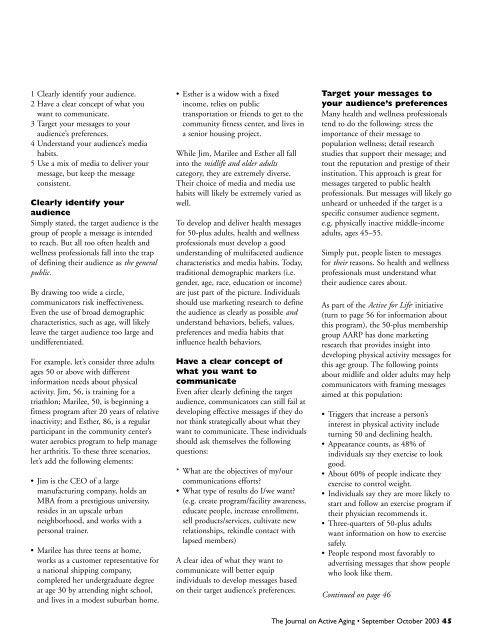Cutting through media clutter: five rules for ... - Active for Life
Cutting through media clutter: five rules for ... - Active for Life
Cutting through media clutter: five rules for ... - Active for Life
Create successful ePaper yourself
Turn your PDF publications into a flip-book with our unique Google optimized e-Paper software.
1 Clearly identify your audience.<br />
2 Have a clear concept of what you<br />
want to communicate.<br />
3 Target your messages to your<br />
audience’s preferences.<br />
4 Understand your audience’s <strong>media</strong><br />
habits.<br />
5 Use a mix of <strong>media</strong> to deliver your<br />
message, but keep the message<br />
consistent.<br />
Clearly identify your<br />
audience<br />
Simply stated, the target audience is the<br />
group of people a message is intended<br />
to reach. But all too often health and<br />
wellness professionals fall into the trap<br />
of defining their audience as the general<br />
public.<br />
By drawing too wide a circle,<br />
communicators risk ineffectiveness.<br />
Even the use of broad demographic<br />
characteristics, such as age, will likely<br />
leave the target audience too large and<br />
undifferentiated.<br />
For example, let’s consider three adults<br />
ages 50 or above with different<br />
in<strong>for</strong>mation needs about physical<br />
activity. Jim, 56, is training <strong>for</strong> a<br />
triathlon; Marilee, 50, is beginning a<br />
fitness program after 20 years of relative<br />
inactivity; and Esther, 86, is a regular<br />
participant in the community center’s<br />
water aerobics program to help manage<br />
her arthritis. To these three scenarios,<br />
let’s add the following elements:<br />
• Jim is the CEO of a large<br />
manufacturing company, holds an<br />
MBA from a prestigious university,<br />
resides in an upscale urban<br />
neighborhood, and works with a<br />
personal trainer.<br />
• Marilee has three teens at home,<br />
works as a customer representative <strong>for</strong><br />
a national shipping company,<br />
completed her undergraduate degree<br />
at age 30 by attending night school,<br />
and lives in a modest suburban home.<br />
• Esther is a widow with a fixed<br />
income, relies on public<br />
transportation or friends to get to the<br />
community fitness center, and lives in<br />
a senior housing project.<br />
While Jim, Marilee and Esther all fall<br />
into the midlife and older adults<br />
category, they are extremely diverse.<br />
Their choice of <strong>media</strong> and <strong>media</strong> use<br />
habits will likely be extremely varied as<br />
well.<br />
To develop and deliver health messages<br />
<strong>for</strong> 50-plus adults, health and wellness<br />
professionals must develop a good<br />
understanding of multifaceted audience<br />
characteristics and <strong>media</strong> habits. Today,<br />
traditional demographic markers (i.e.<br />
gender, age, race, education or income)<br />
are just part of the picture. Individuals<br />
should use marketing research to define<br />
the audience as clearly as possible and<br />
understand behaviors, beliefs, values,<br />
preferences and <strong>media</strong> habits that<br />
influence health behaviors.<br />
Have a clear concept of<br />
what you want to<br />
communicate<br />
Even after clearly defining the target<br />
audience, communicators can still fail at<br />
developing effective messages if they do<br />
not think strategically about what they<br />
want to communicate. These individuals<br />
should ask themselves the following<br />
questions:<br />
* What are the objectives of my/our<br />
communications ef<strong>for</strong>ts?<br />
• What type of results do I/we want?<br />
(e.g. create program/facility awareness,<br />
educate people, increase enrollment,<br />
sell products/services, cultivate new<br />
relationships, rekindle contact with<br />
lapsed members)<br />
A clear idea of what they want to<br />
communicate will better equip<br />
individuals to develop messages based<br />
on their target audience’s preferences.<br />
Target your messages to<br />
your audience’s preferences<br />
Many health and wellness professionals<br />
tend to do the following: stress the<br />
importance of their message to<br />
population wellness; detail research<br />
studies that support their message; and<br />
tout the reputation and prestige of their<br />
institution. This approach is great <strong>for</strong><br />
messages targeted to public health<br />
professionals. But messages will likely go<br />
unheard or unheeded if the target is a<br />
specific consumer audience segment,<br />
e.g. physically inactive middle-income<br />
adults, ages 45–55.<br />
Simply put, people listen to messages<br />
<strong>for</strong> their reasons. So health and wellness<br />
professionals must understand what<br />
their audience cares about.<br />
As part of the <strong>Active</strong> <strong>for</strong> <strong>Life</strong> ‚ initiative<br />
(turn to page 56 <strong>for</strong> in<strong>for</strong>mation about<br />
this program), the 50-plus membership<br />
group AARP has done marketing<br />
research that provides insight into<br />
developing physical activity messages <strong>for</strong><br />
this age group. The following points<br />
about midlife and older adults may help<br />
communicators with framing messages<br />
aimed at this population:<br />
• Triggers that increase a person’s<br />
interest in physical activity include<br />
turning 50 and declining health.<br />
• Appearance counts, as 48% of<br />
individuals say they exercise to look<br />
good.<br />
• About 60% of people indicate they<br />
exercise to control weight.<br />
• Individuals say they are more likely to<br />
start and follow an exercise program if<br />
their physician recommends it.<br />
• Three-quarters of 50-plus adults<br />
want in<strong>for</strong>mation on how to exercise<br />
safely.<br />
• People respond most favorably to<br />
advertising messages that show people<br />
who look like them.<br />
Continued on page 46<br />
The Journal on <strong>Active</strong> Aging • September October 2003 45





